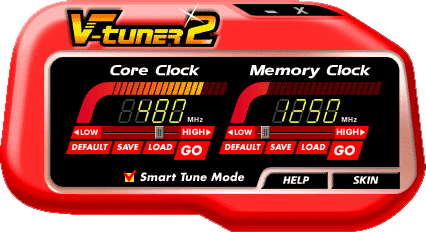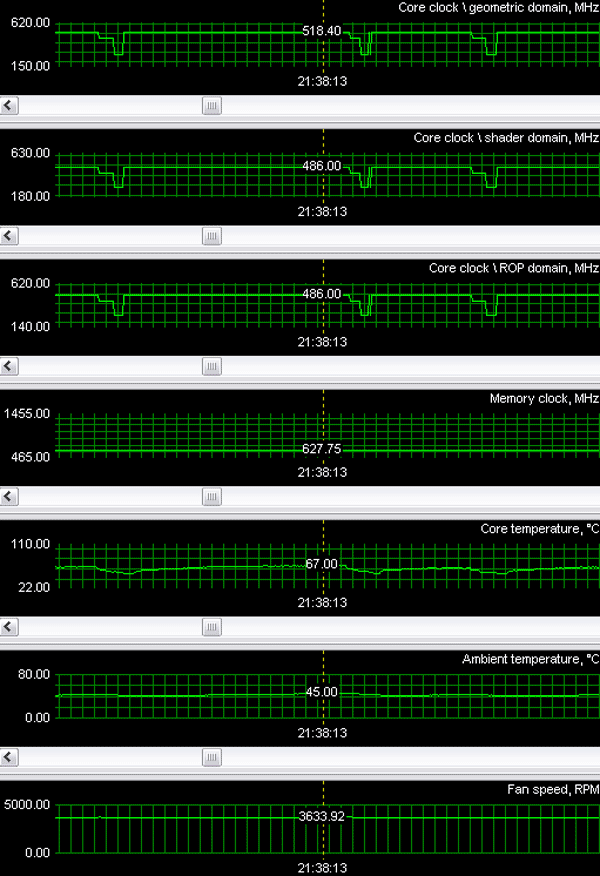 |
||
|
||
| ||
The sky breathed autumn, time was flowing,
and good old sun more seldom glowing; the days grew shorter, in the glade with mournful sound the secret shade was stripped away, and mists encroaching lay on the fields; in caravan the clamorous honking geese began their southward flight: one saw approaching the season which is such a bore -- November stood outside the door. A.S.Pushkin
TABLE OF CONTENTSIndeed, the scorching summer is over, bestowing excellent holiday feelings on some people and leaving overheating nightmares to the others (I mean modern 3D accelerators and system units on the whole). It's time for gravity, pensiveness, and business. In that very tone we shall proceed to review new production-line video cards. Today we are going to review two products from Gigabyte. The first card is based on NVIDIA GeForce 7800 GTX. It's interesting for its raised frequencies (compared to the nominal) in the first place. It's actually become quite fashionable to launch such cards with "legitimized" overclocking. The fame of previously exclusive cards like Gainward Golden Sample has dwindled. There is hardly any company that didn't do the same thing, especially as the G70 is well known for its overclocking. Memory must operate at higher frequencies, as in the standard mode (we mean the card) it still operates at reduced frequencies (versus the nominal frequency). The frequencies are raised to 480/1250 MHz. Considering that the core clocks of the shader unit and ROP may change only at 27 MHz steps, the real core clocks will be 486 MHz for Shader/ROP units and 520 MHz for the geometry unit. We already had a similar situation with a video card from ASUS. But it offered higher memory operating frequency. However, the resulting performance difference between the above mentioned video card and the Gigabyte product will not be very large I guess. I think this product will be very popular among those who play the most graphics-intensive games and who like to configure the graphics quality to maximum. The second card from Gigabyte is based on the ATI RADEON X800 XL. It a middle end product among Hi-End accelerators, so to speak. That's practically the only accelerator from the Canadian company equipped with 512 MB of local memory. Whether it really needs such memory capacity will be reviewed below. The video card itself is of a very original design (but I think that the starting point for this model was the same card from PowerColor. We already reviewed it. It was the first model to use a cooling system consisting of two heatsinks with a fan on the rear one). You can watch a video, which will brief you up on the new cards, being more illustrative at the same time: WMV, 15MB So, let's examine the cards.
Video Cards
The GeForce 7800GTX from Gigabyte is evidently the same reference card, you can see it well on the photos. Gigabyte has to do with the cooler label only. And that's it. And, of course, its employees select cards that can operate at increased frequencies. But sometimes you may still come across GTX cards, which fail to operate at core frequencies higher than 460 MHz. I don't know where the cards are selected and on what level: chips or ready cards. NVIDIA has ready cards tested SOMEWHERE at the production stage or when the cards are delivered to Gigabyte storehouse. I guess NVIDIA will hardly take up such questions, even at partners' requests. So I'm inclined to believe that ready-made cards are delivered to Gigabyte test lab to be selected there. The X800 XL based card is also a complete copy of the reference design, except for one thing: it does not use external power supply. Since the very first reviews of such cards, I have suspected that ATI soldered this connector and corresponding elements on a PCB to be on the safe side. But in reality the power consumption does not exceed the known 75 W (the maximum current, which motherboards with PCI-E can provide). We shall not review the cooling systems, as the X800XL-based card with 512 MB
has nearly the same cooling device as in the previously examined card
from PowerColor. What concerns the GTX-based
card, it has a reference cooler, reviewed many times in 7800GTX articles
(see the list below).
You could have already seen it on the collage that the fan on the Gigabyte RADEON X800 XL 512MB features nice blue illumination. That's how it looks in the dark. You can also watch our video and see it "live". This cooling system makes the card rather bulky. Besides, the bundle includes a bracket with a small fan to blow to the heatsink from the front edge of the motherboard (it's for overclockers, as the video card does not overheat at standard frequencies even without additional cooling).
Bundle
Box.

Installation and DriversTestbed configurations:
Gigabyte has been including the proprietary VTuner utility with its cards for a long time. But now we are interested in its component, responsible for overclocking, that is the one that allows you to control operating frequencies. The first screenshot shows the GTX operating frequency in 2D, the second one - in 3D. Of course, this very utility works fine with the X800 XL as well.


We monitored core temperatures in closed PC case without additional cooling (room temperature: +22°C) with RivaTuner, written by A.Nikolaychuk AKA Unwinder, and here is what we got:
For Gigabyte GeForce 7800GTX TurboForce 256MB Gigabyte RADEON X800 XL 512MB As you can see, the maximum core temperatures were not too high to worry about. The relatively low room temperature might have to do with it.
And here goes something new. To be more exact, a kink offered by the RivaTuner author in the latest version (15.7). It's monitoring the local video memory usage in 3D mode. Considering that one of today's cards under review has 512 MB of memory, it's interesting to see how much video memory is actually requested by applications in the heaviest mode 1600x1200 with AA+AF. We ran these tests on Gigabyte RADEON X800 XL 512MB.
The Chronicles Of Riddick: Escape From Butcher Bay
Three surges to maximum video memory usage were provoked by launching applications in lower resolutions (1024 and 1280); these modes logically require less memory. So, this heavy game requires 225 MB of memory for 1600x1200 with AA+AF. Theoretically, all modern powerful accelerators possess this memory capacity, so there will be no intensive transmissions via the bus.
Half-Life2
HL2 also requires slightly more than 200 MB of local video memory in this mode. That's no problem for high-performance accelerators as well. However, you should also take into account the CPU-dependency of this application; the memory capacity is not the most critical requirement of this game to this accelerator.
FarCry
It's almost a similar situation. We know well this brilliant title has dulled already and does not look such a monster that gobbles up all resources of your accelerator.
DOOM III
The situation in this game is closer to CR. The heaviest mode with High-Quality (in the game) requires more memory, but still less than 256 MB (minus expenses for frame-buffers). However, the gameplay is at its lowest even with the most powerful cards (memory capacity is obviously not the bottleneck here).
3DMark05
The first test (Game1) turns out the most critical to memory capacity, it requires 231 MB in 1600x1200 mode. But again 256 MB accelerators cope with it easily. F.E.A.R. Here it is! We have finally found a graphics-intensive game, which demanded as much as 380 MB! However, you will see in the performance test results below that there is almost no difference between the X800 XL 256 MB and 512 MB. Even in 1600x1200. What's up? That's because the bottleneck is the GPU itself, its capacity. Have a look at the performance results, even top products do not provide more than 80 fps. That's why even if you run out of local video memory and the system swaps to use system RAM via the bus, you will not notice it, as the video card's core slows the system down, so that the bus exchange is carried out without delays.
It will be interesting to see how the fastest 512 MB card (but we have no such cards so far) will act.
Splinter Cell Chaos of Theory This game, despite its complexity and tough shader effects, requires little of local video memory. The conclusion suggests itself: a middle-end card has no need for 512 MB so far, even if it's close to Hi-End. But... New games appear on the horizon. CoD2 and SS2 demos are already out. Rumors have it that they will require more than 256 MB. We shall see in two weeks. Test results: performance comparisonWe used the following test applications:
I guess there is no point in demonstrating performance of the Gigabyte GeForce 7800GTX TurboForce 256MB separately, as it differs from the card running at 486/1350 MHz (on the diagrams above) only by 5-7% (all modern games are critical to the core capacity in the first place).
ConclusionsGigabyte GeForce 7800GTX TurboForce 256MB is an excellent product for enthusiasts and exacting players, who can afford to spend over 500 USD for a video card. The video card possesses everything necessary today for the most hard-driving 3D games. Indeed, the price is high. But that's Hi-End for you, it's available only to the elite, ready to pay so much money for high performance and no compromises with quality (it must be top quality). This sample demonstrated excellent 2D quality, the card did a great job. I didn't analyze overclocking, as I was pressed for time. Gigabyte RADEON X800 XL 512MB - the X800 XL is very attractive as it is, we have noted it many times. But does it really need 512 MB? - That's a vexed question. Even when an application needs more than 256 MB, the main bottleneck is the core, not memory bandwidth or size. I shall not draw final conclusions until I carry out my tests in new SS2 and COD2 demos. The card itself is very attractive; the cooler noise is very low; you should understand that its overclocking capacity is not very good, like in any R430-based card. No external power supply adds a little advantage (you don't need go looking for adapters, etc). The card works perfectly, 2D quality is excellent.
You can find more detailed comparisons of various video cards in our 3Digest.
Theoretical materials and reviews of video cards, which concern functional properties of the GPU ATI RADEON X800 (R420)/X850 (R480)/X700 (RV410) and NVIDIA GeForce 6800 (NV40/45)/6600 (NV43)
Write a comment below. No registration needed!
|
Platform · Video · Multimedia · Mobile · Other || About us & Privacy policy · Twitter · Facebook Copyright © Byrds Research & Publishing, Ltd., 1997–2011. All rights reserved. | |||||||||||||||||||||||||||||||||||||||||||||||||||||||||||||||